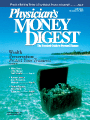Publication
Article
Physician's Money Digest
So, You Want to Be a Doctor?
Author(s):
"It's a very rewarding profession,but it's hard work. You have towant to be a doctor," my physician-dad once told me about hischosen profession. And it was a professionwhen he practiced in his prime some25 years ago. It's not today. "Now it's abusiness," my dad laments.
Whether dad is accurate on that isdebatable. What seems certain, though, isthat the doctor business is losing its lusterat least as far as physicians are concerned—or future physicians, that is.
Although applications to US medicalschools for the 2003 to 2004 year wereup 3.4%, according to a recent AMAreport, the bump represented the first increasein 7 years. A total of 34,785 applicationswere made to medical schoolsthis year—with a 51% female to 49%male applicant ratio.
Trend and Tale
Is this just a blip or is it a trend?Going back to 1996, the number of medschool applicants has fallen an average ofabout 5% per year. Over a 10-year period,the applicant pool reached a head in1996, when nearly 47,000 people soughtentrance to medical school.
During a Thanksgiving phone call, Iasked my dad his opinion on the matter."Sadly, it's all too clear that the physiciancareer is no longer as attractive as it oncewas," he said. "With the malpractice lawsuits,managed care bureaucracy, anddeclining compensation, the potential forboth professional and financial reward iselusive for today's doctors. Other smartpeople see these difficulties and begin tothink about another career." I now realizewhy dad is so content in his retirement.
Still, the news isn't all bad. While thenumber of medical school applicants hasfallen over the past 10 years, the numberof those accepted has remained steady atnearly 17,000 since 1983. Meanwhile,more than 57,000 Medical College AdmissionTests were administered in 2003,a 6% increase over last year.
A Good Living?
At least on the financial side—as thepublishers of this magazine have come tolearn—the concern about the medicalprofession is even more acute. Today'saverage medical school graduate hasnearly $105,000 in educational debt, accordingto the American Association ofMedical Colleges. Starting a new practicein primary care can easily reach$150,000, the AMA estimates. The averagemedical practice will put out approximately50% of gross annual revenuesjust to keep the doors open, the NationalAssociation of Healthcare Consultantsreports. "No one said being a doctor waseasy," my dad concludes.
